How Efficient are Bifacial Solar Panels? | Product Review
While visiting Renogy Solar in Ontario, CA last month, we picked up their brand new 220W Bifacial Solar Panel to give it a test. We camped at a nearby state park in Southern California for a few days and ran it through its paces to get an idea of how well the panel worked in the following situations: 1) flat vs. tilted at a 45 degree angle (using an RV Tilt Mount Brackets), 2) reverse angle with panel facing away from the sun, and 3) sitting on black vs. white surface. We also tested and compared the percentage of energy loss with partially-shaded conditions.
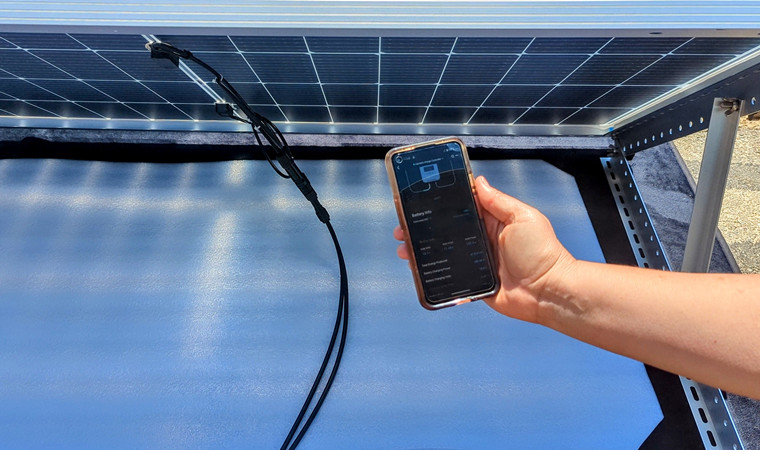
What’s the Difference between Monofacial and Bifacial Panels?
Most solar panels are solid white on one side and have solar cells on the other. With a bifacial panel, both sides of the panel are equipped with solar cells to capture more light, including the light which bounces off a reflective (or white surface) from the back side of the panel. Just think of the increased efficiency in sandy (≅11.8% increase) or snowy (≅24.6% increase) regions! Bifacial panels used in snowy environments can also cause snow to melt faster as they heat up from the back, melting the snow load on the front. To learn more about how these panels are constructed as well as the advantages and disadvantages of bifacial solar panels, check out this article.
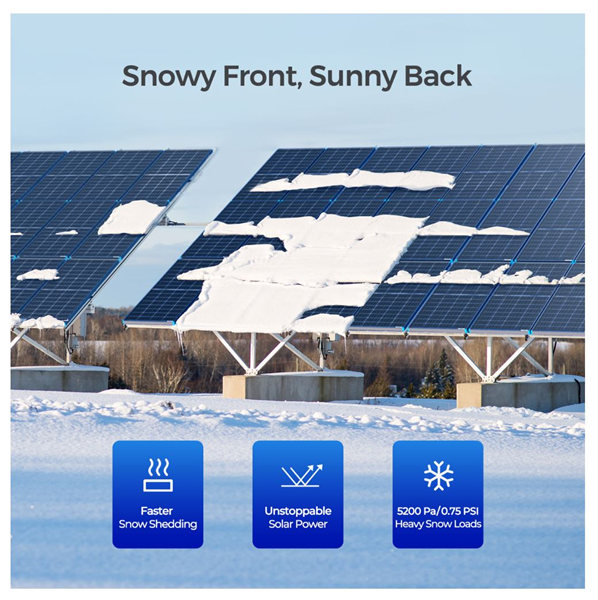
Can You Use Bifacial Panels on a Roof?
For homeowners, these new bifacial panels are an excellent choice for pergolas, sunrooms, patio covers, and those who have their panels on an elevated tilt-mount. If mounted on a roof, it’s important for the roof to be reflective (using a light-colored aluminum roofing material) rather than a dark color in order to get the most benefit from the bifacial nature of the panel. To further increase solar gain and efficiency, the panels should be permanently tilted or have the ability to be adjusted.
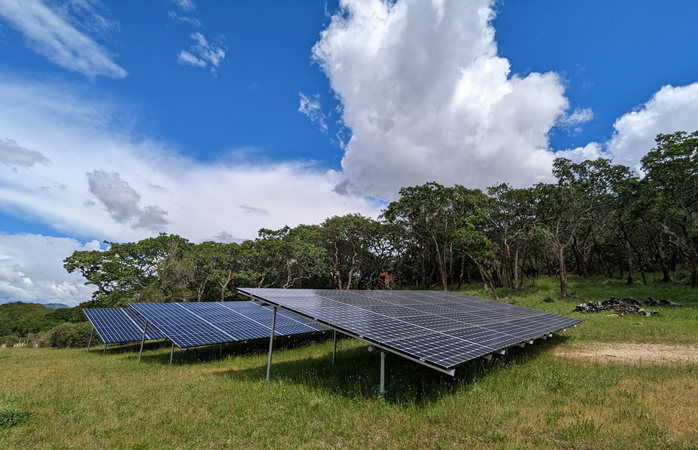
For RVs or vans, these bifacial panels will work in a variety of applications from rooftops to side awnings to a portable ground panel, with tilt mount brackets being the name of the game for optimal efficiency. Since you aren’t always able to choose the most optimal way to park your rig within a campground that has designated spots, it’s helpful to have a panel which will generate power from both sides, thereby capturing as much sun as possible and generating the most energy without having to move your vehicle. And, for boat owners, the water will make the perfect reflective surface to augment your solar gain.
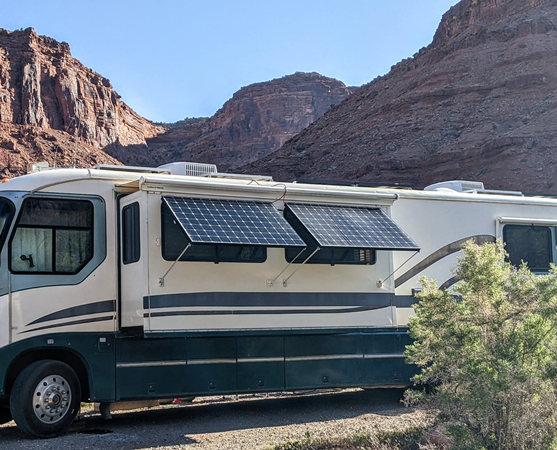
Bifacial Solar Panels vs Monocrystalline Solar Panels?
It’s important to not confuse the terms monofacial and monocrystalline. Monofacial refers to a panel with solar cells on only one side while monocrystalline refers to the way the cells themselves are constructed. Bifacial panels are typically made of monocrystalline cells, which are much more efficient than older polycrystalline cells. The term 'mono' means ‘single’, which tells us that the solar cells are manufactured from a single crystal with a uniform structure. This uniform structure consequently allows the electrons to move more freely throughout the cell and thus produce better power generation per unit area of the cell, which is the very definition of “efficiency” itself, right? Monocrystalline solar panels frequently offer 20% (or more) efficiency, which is significantly higher than their older polycrystalline counterparts. Overall, when comparing bifacial panels, make sure you purchase a monocrystalline version.
How Efficient Are Bifacial Solar Panels?
To compare and contrast the efficiency of bifacial vs. monofacial and traditional (older) monocrystalline panels vs. those with the new half-cut 64 cell design, we set up the following test. We used the new Renogy 220 Bifacial Solar Panel on an RV Tilt Mount and compared it side-by-side with our 100W Solar Suitcase (monocrystalline, monofacial panel). Our 100W panel has been in use for just over a year now. We used the free Renogy DC Home app connected to a BT-2 module to read and gather data from each panel. While we realize these panels are very different wattages, we were able to correlate some data using percentages. See our table below for details.
We tested both panels on the same day under virtually the same atmospheric conditions in early April 2023 in Southern California (latitude: 33.98°N) during the mid-day (between 11am-3pm), with full sun and no cloud cover. It was about 80-83 ℉ outside during our test. Both panels were tested using a 20ft 10AWG extension cable connected to a 40A Rover Elite Charge Controller that was charging a 100Ah Self-Heating LFP battery. We adjusted the panels slightly before each test to make sure they were aimed directly at the sun as it moved through the sky during the afternoon. It’s important to note that we were not trying to create a laboratory test; rather, our goal was to see how well this panel functions in real world conditions, in different orientations and with different reflective surfaces.
To compare apples to apples, we’ve created a table (see below) to analyze the data we collected using percentages of each panel’s nominal wattage. There are several factors which may affect these numbers, such as atmospheric conditions (clouds, humidity, fog, smog, etc.), ambient temperature, time of day, and battery status. Before this test, we drew our battery down to about 70% so that the charge controller would not throttle back the current coming in as the battery status approached 100%.
Let’s get into some of the numbers from our tests…
In the angled position and facing the sun, the two different panels produced a wattage of about the same percentage, with the bifacial panel producing a maximum of 84% and the solar suitcase producing 86% of their nominal wattage, respectively. This means we are working with equally efficient panels…check!
In the flat installation, the bifacial panel really outperformed the suitcase, producing 80% compared to 71%. But, with a reverse angle orientation, this is where the bifacial really outshines the suitcase at 39% vs.17%! Additionally, the bifacial seemed to outperform the suitcase when partially shaded at 70% vs. 45%.
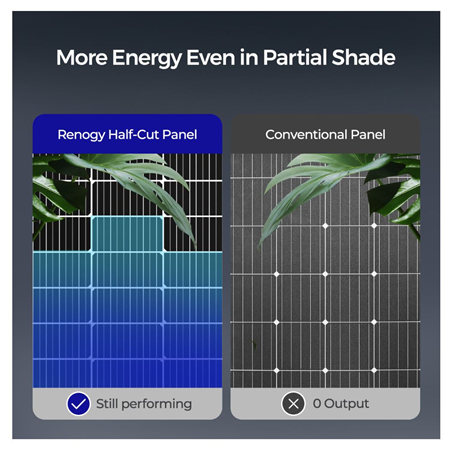
So, what we’re taking away from this is that the bifacial panel is more versatile and performs better in the types of conditions that most RVer’s and boat owners are likely to face. Most folks install their panels flat on their roof, so that they can still move their RV’s around. In our results, the 220W bifacial panel produced a higher percentage of power than the monofacial panel even in a flat orientation. Also, if you are going to park your RV for a while and take advantage of those tilt mounts for greater efficiency, then the bifacial may help you take advantage of that lower sun angle earlier in the morning and later in the evening (as well as during the fall, winter, and spring). Overall, it can produce more power than the monofacial, single-sided panel when not optimally facing the sun.
See our table below for a summary of how well bifacial solar panels work under real world conditions.
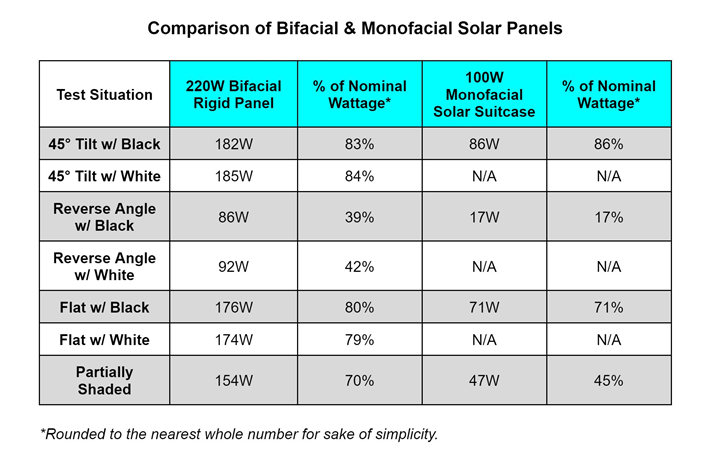
For the Solar Nerds Out There! Bifacial Solar Panels Specifications & Terminology
In addition to featuring “premium Grade A+ monocrystalline solar cells” and “half-cut 64 cells” to increase efficiency in partial shade, the Renogy website states that these panels include PERC technology, 10 busbars, and a bypass diode network. Wait…what?!? Let’s break this terminology down a bit for those of us who are not solar engineers, so we can better understand why these features are an important part of making solar panels as efficient as possible.
● Grade A+ Monocrystalline Solar Cells: Grade A solar panels are the best solar cells on the market. They have no visual defects and meet performance specifications, as well as carry manufacturer warranties – guaranteeing their quality and performance and letting you know the manufacturer’s confidence in their solar panels. Renogy’s 220W bifacial panels carry a 25 year warranty. Curious about how solar panels are graded? Check out this article-What Are Solar Panels Made Out Of. In the article, solar cells are categorized as A, B, or C grade in the “Solar Cell Testing” process.
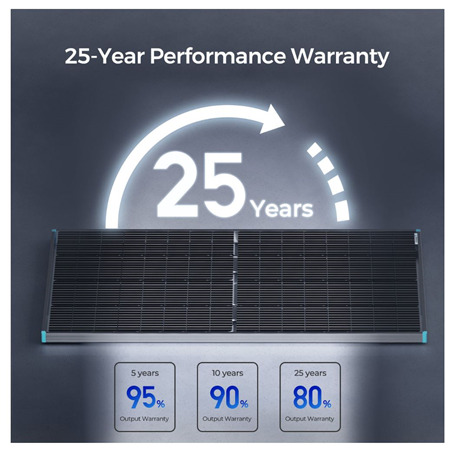
● Half-Cut 64 Cells: Half-cut solar cells increase both performance (lower current = less energy loss due to resistance within cells) and durability (smaller size = more resistant to cracking). According to Energy Sage, “By cutting solar cells in half, the current generated from each cell is halved, and lower current flowing through leads to lower resistive losses as electricity moves throughout cells and wires in a solar panel.” So, for installations where shading and space are limiting factors, half-cut cells can help make a solar panel installation more cost-effective over the long term. Bottomline, this aspect of the bifacial panels makes them more effective and efficient when partially-shaded, as we’ve shown in our product review video.
● PERC Technology: PERC stands for Passivated Emitter and Rear Cell technology. Well that clears it up, right? Basically, it means that new and improved cell technology allows more photons to be captured by the silicon, meaning each cell makes a little more electricity than it would without the PERC layers.
● Bus Bars: Bus bars are solid metal bars used to carry current which are typically made from copper or aluminum. Bus bars are rigid, flat, and wider than cables, and can carry more current than cables within the same cross-sectional area. Furthermore, the larger surface area of a bus bar dissipates heat more efficiently than a cable over its entire length. Using 10 bus bars increases overall efficiency within the solar panel itself.
● Bypass Diode Network: Bypass diodes are connected in parallel with a series of solar cells, all within a module or a panel. These little diodes allow current to bypass a cell that is shaded, faulty, or covered with debris, thus preventing it from becoming a hotspot that can overheat and degrade the module. It’s kind of like having heart bypass surgery so your ticker keeps working properly when your arteries have become clogged. Thus, bypassing problem areas within a solar panel increases its overall efficiency.
There you have it! For maximum efficiency, Renogy put all of these high-end features into one panel that can generate power from both sides. And, for the complete picture of what’s going on inside that bifacial panel, here are the specifications direct from the Renogy website.
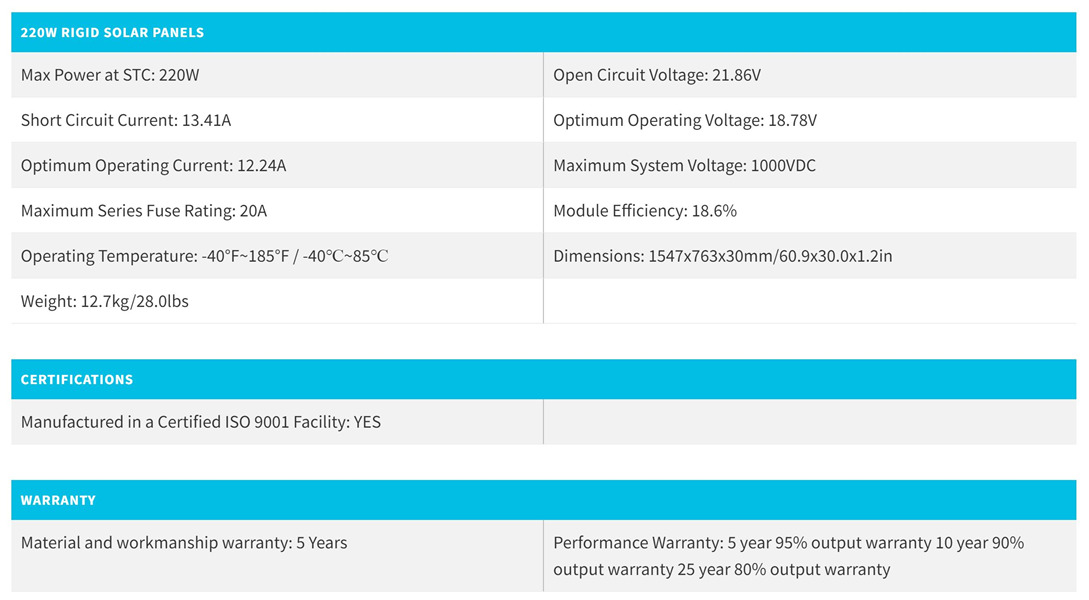
You’ll note that with overall dimensions of the 220W bifacial panel (60.9 x 30 x1.2”) just slightly larger than the traditional, single-sided 200W panel (58.7 x 27.5 x 1.38”), you’re actually getting more solar panel with higher efficiency in a similar footprint. As of the date of this publication, the 220W bifacial panel is only $10 more per panel than the traditional, monofacial 200W panel.
So, the big question… are bifacial solar panels worth it? After this test, we sure think so! And, if you use them with the best possible reflective surface, they can greatly increase the efficiency of your overall system.

In 2012, Shari Galiardi & David Hutchison left behind careers and a comfortable home in North Carolina to travel with the vintage camper trailer they lovingly restored, outfitted with solar, and named "Hamlet." What began as a short break from careers and responsibility quickly turned into a love affair with roadlife. They have parlayed their higher education backgrounds, desire for life-long learning, and thirst for adventure travel into writing, photography, video production, and public speaking gigs from coast to coast. Known to their friends as simply Shari & Hutch, you can learn more about their full-time, solar-powered adventures on their website at freedominacan.com. Or, follow them on Facebook, Instagram, and YouTube as “Freedom in a Can, LLC.”
Related articles:
Do Solar Panels Need Direct Sunlight?
Adding Solar Panels To Existing System | Is It Feasible?
Most Efficient Solar Panels: Harnessing The Sun For Maximum Savings








